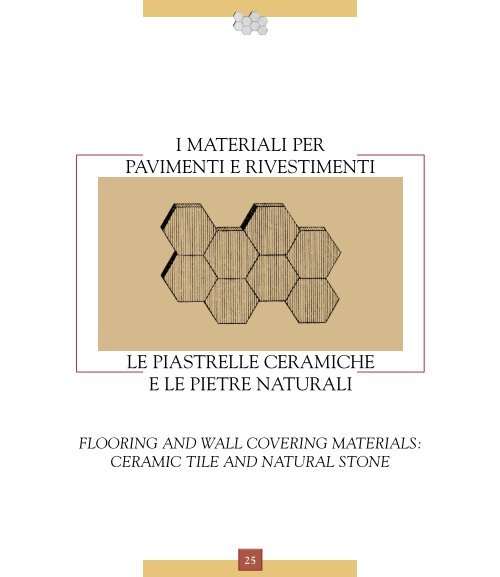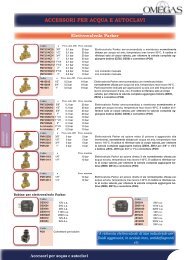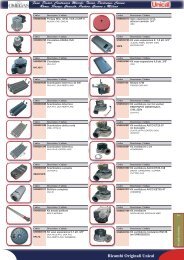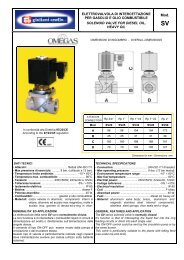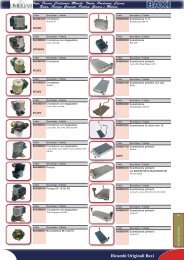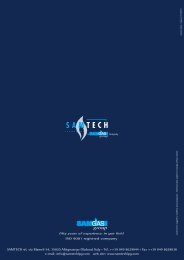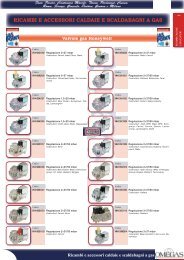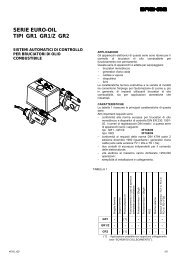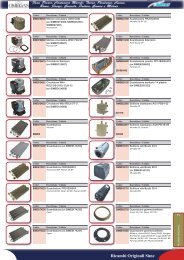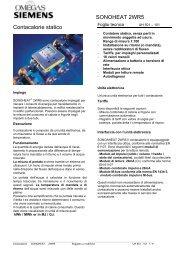i materiali per pavimenti e rivestimenti le piastrelle ceramiche e
i materiali per pavimenti e rivestimenti le piastrelle ceramiche e
i materiali per pavimenti e rivestimenti le piastrelle ceramiche e
You also want an ePaper? Increase the reach of your titles
YUMPU automatically turns print PDFs into web optimized ePapers that Google loves.
I MATERIALI PER<br />
PAVIMENTI E RIVESTIMENTI<br />
LE PIASTRELLE CERAMICHE<br />
E LE PIETRE NATURALI<br />
FLOORING AND WALL COVERING MATERIALS:<br />
CERAMIC TILE AND NATURAL STONE<br />
25
FLOORING AND WALL<br />
COVERING MATERIALS<br />
CERAMIC TILE AND<br />
NATURAL STONE<br />
I MATERIALI PER PAVIMENTI E<br />
RIVESTIMENTI<br />
LE PIASTRELLE CERAMICHE E LE<br />
PIETRE NATURALI<br />
A HISTORY OF CERAMIC<br />
TILE<br />
CENNI STORICI SULLE PIASTRELLE CERAMICHE<br />
“Ciotola, statua, vaso o parato architettonico, la storia della<br />
ceramica ha mil<strong>le</strong>nni di vita e di ricerche, di espressioni e d’amore,<br />
è testimonianza della vita, del gusto e della presenza<br />
dell’umanità sulla Terra. Per questo restiamo affascinati<br />
dinanzi al capolavoro d’arte ceramica con cui i Babilonesi<br />
decorarono la grande porta ed il via<strong>le</strong> di Ishtihar, a Babilonia;<br />
così andiamo con amore alla ricerca dei più antichi re<strong>per</strong>ti<br />
decorativi su pareti e monumenti in Egitto, ove sin dal terzo<br />
mil<strong>le</strong>nnio a.C. eran già note co<strong>per</strong>ture a mosaico di ceramica.<br />
I mattoni a smalto della porta di Ishtihar a Babilonia risalgono<br />
al 605-562 a.C., ed i manufatti achmenidi (la sp<strong>le</strong>ndida<br />
Teoria degli arcieri del palazzo di Susa) al V-IV secolo a.C. La<br />
Cina, con <strong>le</strong> alte tem<strong>per</strong>ature con cui giunsero grès e porcellana<br />
(1200/1350 gradi) dovette elaborare nuovi smalti e<br />
nuovi fondenti duri. Qui l’uso di grandi lastre di semplice terracotta<br />
è accertato sin dal <strong>per</strong>iodo Han (206 a.C. - 270 d.C.).<br />
Forse il parato ceramico iniziò nel VII secolo d.C., con riguardo<br />
soprattutto al ricco tetto di tego<strong>le</strong> a smalto verde-blu e ricchi<br />
acroteri figurati. Tra VIII e IX secolo si diffuse nel mondo<br />
islamico una bella ceramica, forse imitazione, appunto, di<br />
quella cinese. I Turchi selciukidi introdussero l’uso della grande<br />
lastra di argilla magra sciamottata e due tecniche di rivestimento:<br />
quella a mosaico di ceramica (lambrissage) e quella<br />
a piastrel<strong>le</strong>, con un caratteristico parato <strong>per</strong> interni composto<br />
“Bowls, statues, vases, architectural<br />
decoration: the history of ceramics<br />
goes back thousands of years, involves<br />
extensive research and dedication, and<br />
takes on different forms of expression.<br />
It is a testimony of life, of <strong>per</strong>sonal<br />
taste and the presence of humankind<br />
on the earth. This is the reason why<br />
we are fascinated by<br />
the masterpiece of<br />
ceramic art with which<br />
the Babylonians decorated<br />
the great gate<br />
and the main street in<br />
Ishtihar. We lovingly<br />
seek out the most<br />
ancient decorative findings<br />
on walls and<br />
monuments in Egypt,<br />
where mosaics were a<br />
well-known form of<br />
wall covering as early<br />
as the third mil<strong>le</strong>nnium<br />
B.C.. Glazed<br />
bricks on the gate at<br />
Ishtihar in Babylon date back to 605-<br />
562 B.C., and Achaemenid products<br />
(the sp<strong>le</strong>ndid Archers’ Series in the<br />
Susa Palace) to the 5th or 6th century<br />
B.C. In China, with the high firing<br />
tem<strong>per</strong>atures that yielded stoneware<br />
and porcelain (2192 - 2462 degrees),<br />
new glazes and hard fluxes had to be<br />
developed. Here it is certain that large<br />
slabs of simp<strong>le</strong> terracotta were used as<br />
early the Han Dynasty (206 B.C.-<br />
270 A.D.).<br />
Ceramic decoration may have had its<br />
origin in the 7th century A.D.; in particular,<br />
it is thought that the rich greenblue<br />
glazed ti<strong>le</strong> roof and figured acroters<br />
were developed then. Between the<br />
8th and the 9th century, beautiful<br />
ceramics spread throughout the Islamic<br />
world, <strong>per</strong>haps imitations of Chinese<br />
ceramics.<br />
The Seljuk Turks introduced the use of<br />
the large slab of “sciamottata” sandy<br />
clay and two wall covering techniques:<br />
ceramic mosaics<br />
(lambrequin) and<br />
ceramic ti<strong>le</strong> covering,<br />
the latter typically<br />
used with a design for<br />
interiors made up of<br />
an eight-pointed star<br />
and “pointed crosses”.<br />
The Turks also<br />
invented the reduction<br />
lustre, of which<br />
the Abbasids of<br />
Samarra and the<br />
Tulunids of Egypt<br />
became important<br />
producers. During<br />
the Timuric <strong>per</strong>iod<br />
(1387-1502) ceramic decoration for<br />
architecture in Islamic countries<br />
reached a peak; the city par excel<strong>le</strong>nce<br />
may be said to have been<br />
Samarkanda, which was comp<strong>le</strong>tely<br />
covered with glazed majolica ti<strong>le</strong>s.<br />
The earliest European glazes were<br />
developed following the Islamic examp<strong>le</strong>,<br />
and between the 13th and 14th<br />
centuries majolica ti<strong>le</strong>s contrasted with<br />
the rough effect of brickwork on<br />
church façades. With the Della<br />
Robbias, during the 15th century ceramics<br />
became an art, seen especially<br />
on altarpieces and devotional altars.<br />
26
Less important decorations in ceramic<br />
ti<strong>le</strong> began to appear in architectural<br />
comp<strong>le</strong>xes, especially in the flooring.<br />
The Renaissance gave a more definite<br />
direction to the use of the paving ti<strong>le</strong><br />
with a pictorial tendency. Its use<br />
spread to the extent that it can be said<br />
that all of Europe looked to Italy as an<br />
examp<strong>le</strong> during the 16th century.<br />
There was, for instance, Faenza, with<br />
its new “covering”. In Spain,<br />
traditional Islamic techniques came<br />
back to life and were adapted to the<br />
Catholic environment, whi<strong>le</strong> the development<br />
of ceramics in France<br />
centred around the work of Masseot<br />
Abaquesne, between 1526 and 1564.<br />
The greatest use of decorative ti<strong>le</strong>s<br />
da stel<strong>le</strong> ad otto punte e «croci aguzze». Del pari i Turchi<br />
idearono il lustro <strong>per</strong> riduzione di cui furono grandi produttori<br />
gli Abbasidi a Samarra ed i Tulunidi in Egitto. Col <strong>per</strong>iodo<br />
timuride (1387-1502) la decorazione ceramica <strong>per</strong> architettura<br />
nei paesi islamici raggiunge l’apogeo<br />
e la città che <strong>per</strong> eccel<strong>le</strong>nza è, si<br />
può dire, del tutto rico<strong>per</strong>ta di maioliche<br />
smaltate è Samarkanda. Sull’esempio<br />
islamico presero <strong>le</strong> mosse i primi smalti<br />
europei e fra il Duecento e Trecento<br />
alcune maioliche fecero contrasto col<br />
ruvidore del cotto sul<strong>le</strong> facciate del<strong>le</strong><br />
chiese. Nel Quattrocento con i Della<br />
Robbia la ceramica diventa arte soprattutto<br />
nel<strong>le</strong> ancone e negli altaroli devozionali;<br />
ma anche decorazioni minori, a<br />
piastrel<strong>le</strong>, entrano a far parte dei comp<strong>le</strong>ssi<br />
architettonici, soprattutto <strong>per</strong> la<br />
pavimentazione. L’ambito rinascimenta<strong>le</strong><br />
dà un senso coerente, a tendenza<br />
pittorica, all’impiego della mattonella,<br />
con una diffusione ed una portata di<br />
ta<strong>le</strong> ampiezza che, nel Cinquecento, si<br />
può dire che l’Europa tutta guardi alla<br />
tipologia italiana. Si pensi infatti a<br />
Faenza ad alla sua nuova «co<strong>per</strong>ta».<br />
Rivivono allora, in Spagna, <strong>le</strong> tradizionali<br />
tecniche islamiche, adattate<br />
all’ambiente cattolico, mentre lo sviluppo<br />
in Francia ha come punto fisso<br />
l’o<strong>per</strong>a di Masseot Abaquesne, attivo<br />
tra il 1526 ed il 1564. Il maggior uso di<br />
piastrel<strong>le</strong> decorative (quasi esclusivamente<br />
<strong>per</strong> interno) si può tuttavia<br />
situare in <strong>per</strong>iodo barocco, con tre aree<br />
maggiori: l’italiana,<br />
la<br />
franco-olandese<br />
e l’iberica (che comprende<br />
Spagna ed Americhe). Spicca l’azu<strong>le</strong>jo,<br />
soprattutto nel<strong>le</strong> Americhe,<br />
mentre in Italia vi è una varietà ricchissima<br />
di cromie armoniose, specie<br />
in Campania ed a Castelli, ove è<br />
preminente la famiglia dei Grue.<br />
Nel Settecento la decorazione ceramica,<br />
raffinata e sensibi<strong>le</strong>, sposa in<br />
particolare la moda del<strong>le</strong> cineserie,<br />
con grande varietà di modelli.<br />
Subentrano nuove tecniche di produzione<br />
ad impronta industria<strong>le</strong><br />
(almost exclusively for interiors) was,<br />
however, during the Baroque <strong>per</strong>iod,<br />
with three main realms, the Italian,<br />
the Franco-Dutch, and the Iberian<br />
(made up of Spain and the Americas).<br />
The azu<strong>le</strong>jo sty<strong>le</strong> was particularly<br />
important, especially in the Americas,<br />
whi<strong>le</strong> in Italy a rich variety of harmonious<br />
colours was being used, especially<br />
in Campania and at Castelli, where<br />
the Grue family ru<strong>le</strong>d.<br />
During the 18th century, refined, sensitive<br />
ceramic decoration combined in<br />
a particular way with the “chinoiserie”<br />
fashion, producing many different<br />
models. New production techniques<br />
were developed on an industrial sca<strong>le</strong><br />
(Sad<strong>le</strong>r & Green, Josiah Wedgwood).<br />
During the Neoclassical <strong>per</strong>iod, ceramic<br />
decoration was limited. Under<br />
Romanticism it took on a “quiet bourgeois<br />
sty<strong>le</strong> indicating a high standard of<br />
living and gentility” and, although<br />
tainted with ec<strong>le</strong>cticism, it did become<br />
popular and widespread.<br />
Finally, with the advent of Modernism<br />
(usually referred to as Art Nouveau)<br />
ceramic decoration exploded onto the<br />
exterior walls of homes. From that<br />
moment on, art and ceramics, sty<strong>le</strong><br />
and decoration were one, as we can<br />
see if we think of the Bauhaus studies,<br />
the importance of Art Deco, Gaudì,<br />
Gali<strong>le</strong>o Chini, Giò Ponti, the Lencis,<br />
27
or Martini. The importance and the<br />
artistic value of ceramics has <strong>per</strong>sisted<br />
throughout the years, and Italy is once<br />
again a <strong>le</strong>ader, thanks to the Marazzi<br />
kilns at Sassuolo, where art, technique,<br />
and sty<strong>le</strong> combine to synthesise<br />
the centuries-long development of<br />
ceramic decoration”.<br />
(Gabrie<strong>le</strong> Mandel)<br />
Ceramic ti<strong>le</strong><br />
(Sad<strong>le</strong>r & Green, Josiah Wedgwood). In <strong>per</strong>iodo Neoclassico<br />
la decorazione ceramica è limitata: col Romanticismo assume<br />
un «queto gusto borghese indice di buon vivere e di genti<strong>le</strong>zza»,<br />
pur se inquinato dall’ec<strong>le</strong>ttismo ma popolarizzato e di<br />
grande diffusione; <strong>per</strong> esplodere finalmente anche sui muri<br />
esterni del<strong>le</strong> dimore con il Modernismo (più usualmente<br />
detto Liberty). Da questo momento arte e ceramica, sti<strong>le</strong> e<br />
decorazione sono unite; basti pensare agli studi del Bauhaus,<br />
all’importanza del Déco, a Gaudì, a Gali<strong>le</strong>o Chini, a Giò<br />
Ponti, al<strong>le</strong> Lenci o a Martini. Una importanza, una presenza<br />
ed un valore d’arte che si protraggono nel tempo a venire, con<br />
l’Italia ancora una volta in preminenza ad o<strong>per</strong>a dei forni<br />
della Marazzi di Sassuolo in cui arte, tecnica e sti<strong>le</strong> si uniscono<br />
<strong>per</strong> sintetizzare il secolare cammino del parato ceramico.”<br />
Gabrie<strong>le</strong> Mandel<br />
LE PIASTRELLE CERAMICHE<br />
the glaze to the ti<strong>le</strong>. The best-known<br />
ceramic products obtained by this<br />
method are majolica ti<strong>le</strong>s and<br />
cottoforte. Majolica ti<strong>le</strong>s are mainly<br />
used for interior wall covering.<br />
The clay body used to make majolica<br />
ti<strong>le</strong>s is normally pinkish, and is usually<br />
glazed with an opaque glaze.<br />
PROCESSO<br />
BICOTTURA<br />
SUPPORTO<br />
stoccaggio M.P.<br />
macinazione<br />
(essiccamento)<br />
PRODUTTIVO<br />
MONO<br />
COTTURA<br />
Ceramic ti<strong>le</strong> belongs to the class of<br />
“ceramic materials” that includes<br />
products made from non-metallic<br />
inorganic substances, first subjected to<br />
a special moulding process, then to a<br />
thermal process by firing which makes<br />
them mechanically resistant. Ti<strong>le</strong>s are<br />
relatively thin slabs of ceramic<br />
material, used for flooring and wall<br />
coverings.<br />
The two main types of ceramic ti<strong>le</strong>s on<br />
the market are:<br />
A) those with designations relating to<br />
technique and technological<br />
characteristics;<br />
B) those with official designations<br />
established by European regulations<br />
published in Italy under the abbreviation<br />
UNI EN and based on water<br />
absorption and method of manufacture.<br />
A) The main ceramic types and<br />
technologies<br />
Doub<strong>le</strong>-fired ti<strong>le</strong><br />
This is the technological process by<br />
which ceramic ti<strong>le</strong>s are produced in<br />
two distinct firing phases. During the<br />
first phase the pressed ti<strong>le</strong>, still green,<br />
is bisque fired, which makes it hard<br />
enough to be hand<strong>le</strong>d. The ti<strong>le</strong><br />
(bisque) is then glazed and decorated<br />
and fired a second time, which fuses<br />
Le piastrel<strong>le</strong> <strong>ceramiche</strong> appartengono alla classe dei “<strong>materiali</strong><br />
ceramici”, i quali comprendono prodotti a base di sostanze<br />
inorganiche non metalliche, sottoposti prima ad un trattamento<br />
di formatura e successivamente ad un trattamento termico<br />
di cottura, che li rende meccanicamente resistenti.<br />
Le piastrel<strong>le</strong> in particolare sono lastre relativamente sottili di<br />
materia<strong>le</strong> ceramico, utilizzato <strong>per</strong> il rivestimento di <strong>pavimenti</strong><br />
e di pareti.<br />
I diversi tipi di piastrel<strong>le</strong> esistenti in commercio sono soggetti<br />
ad una duplice classificazione:<br />
A) denominazione tipologica basata sul<strong>le</strong> caratteristiche tecniche<br />
e tecnologiche<br />
B) denominazione ufficia<strong>le</strong> stabilita dal<strong>le</strong> norme Europee<br />
pubblicate in Italia con la sigla UNI EN che si basano sull’assorbimento<br />
d’acqua e sul metodo di formatura.<br />
A) LE PRINCIPALI TIPOLOGIE-TECNOLOGIE<br />
CERAMICHE<br />
Bicottura<br />
E’ il processo tecnologico mediante il qua<strong>le</strong> si realizza, con<br />
due distinte cotture, la produzione del<strong>le</strong> piastrel<strong>le</strong> <strong>ceramiche</strong>.<br />
Durante la prima fase, la piastrella formata in pressatura ed<br />
ancora “cruda” subisce una cottura (biscottatura) con conseguente<br />
consolidamento del<strong>le</strong> stessa, che assume una consistenza<br />
sufficiente <strong>per</strong> essere maneggiata. La piastrella (biscotto)<br />
viene successivamente smaltata e decorata ed infine subisce<br />
una seconda cottura che consente di fissare gli smalti al<br />
supporto.<br />
I prodotti ceramici ottenuti con questo processo tecnologico<br />
di maggiore notorietà sono la Maiolica ed il Cottoforte.<br />
La Maiolica trova utilizzo preva<strong>le</strong>nte <strong>per</strong> il rivestimento di<br />
pareti interne. Ha un supporto di colore tendenzialmente<br />
pressatura<br />
o<br />
estrusione<br />
essiccamento<br />
cottura<br />
supporto<br />
scelta<br />
PRODUCTION<br />
DOUBLE-<br />
FIRING<br />
pressing<br />
or<br />
extrusion<br />
drying<br />
chosen<br />
support<br />
firing<br />
smaltatura<br />
e<br />
decorazione<br />
cottura<br />
smaltato<br />
scelta<br />
e<br />
imballaggio<br />
SUPPORT<br />
raw material<br />
storage grinding<br />
(drying)<br />
glazing<br />
and<br />
decoration<br />
glazed ti<strong>le</strong><br />
firing<br />
sorting<br />
and<br />
packing<br />
pressatura<br />
o<br />
estrusione<br />
essiccamento<br />
SMALTO<br />
stoccaggio M.P.<br />
frittaggio<br />
macinazione<br />
PROCESS<br />
SINGLE-<br />
FIRING<br />
pressing<br />
or<br />
extrusion<br />
drying<br />
GLAZE<br />
raw material<br />
storage fritting<br />
grinding<br />
28
Cottoforte is a typical Emilian<br />
product. It is used mainly for flooring<br />
and interior wall covering. It has good<br />
mechanical characteristics, and is easy<br />
to glaze and decorate.<br />
Sing<strong>le</strong>-fired ti<strong>le</strong><br />
This is a process by which both the clay<br />
body and the glaze are fired in a sing<strong>le</strong><br />
phase. The ti<strong>le</strong> is glazed and decorated<br />
in its “dried” green state. Firing both<br />
the body and the glaze at the same time<br />
allows for greater fusion between the<br />
glaze and the body. The high firing<br />
tem<strong>per</strong>ature and the low porosity of<br />
the body give the product very special<br />
mechanical characteristics. There are<br />
also types of sing<strong>le</strong>-fired products that<br />
are more porous (monoporosa ti<strong>le</strong>)<br />
that are ideal for situations where<br />
lightweight ti<strong>le</strong>s are required. The<br />
sing<strong>le</strong>-fired ti<strong>le</strong> is a relatively recent<br />
product, but it has spread widely both<br />
nationally and internationally. The<br />
distinction between “white” and “red”<br />
depends on the colour of the body.<br />
rosato che normalmente viene smaltato con smalto non trasparente.<br />
Il Cottoforte è un prodotto tipicamente emiliano. Usato preva<strong>le</strong>ntemente<br />
<strong>per</strong> <strong>pavimenti</strong> e <strong>rivestimenti</strong> interni, possiede<br />
buone caratteristiche meccaniche e faci<strong>le</strong> applicabilità di<br />
smalti e decori.<br />
Monocottura<br />
É il processo produttivo mediante il qua<strong>le</strong> si realizza in una<br />
sola fase, la cottura del supporto e dello smalto.<br />
Smaltatura e decorazione della piastrella avvengono su un<br />
supporto crudo “essiccato”.<br />
La contemporaneità della cottura determina un maggior<br />
<strong>le</strong>game fra smalto e supporto.<br />
L’e<strong>le</strong>vata tem<strong>per</strong>atura di cottura e la bassa porosità del supporto<br />
conferiscono al prodotto caratteristiche meccaniche di<br />
grande ri<strong>le</strong>vanza. Esistono anche tipologie di prodotti in<br />
monocottura caratterizzati da una maggiore porosità (monoporosa)<br />
idonei <strong>per</strong> destinazioni d’uso <strong>le</strong>ggere.<br />
La monocottura è un prodotto relativamente recente ma che<br />
ha avuto grande diffusione naziona<strong>le</strong> ed internaziona<strong>le</strong>. La<br />
distinzione in “bianca” e “rossa” è dovuta al colore del supporto.<br />
29
technical and aesthetic qualities.<br />
CICLO PRODUTTIVO FIRESTREAM<br />
MATERIE PRIME<br />
RAW MATERIALS<br />
Firestream: Enduro ti<strong>le</strong>s production<br />
technology.<br />
In 1985, the Marazzi research centre<br />
developed and patented “Firestream”,<br />
a new ceramic technology for glazing<br />
on an incandescent ti<strong>le</strong> body, used for<br />
production of the Enduro line.<br />
The main phase of this technique takes<br />
place inside the kiln, where the successive<br />
o<strong>per</strong>ations of firing, glazing on<br />
incandescent body, and comp<strong>le</strong>tion of<br />
firing of the vitrified ceramic mixture<br />
all take place. As they pass through<br />
the kiln, the ti<strong>le</strong>s are progressively sintered<br />
at a tem<strong>per</strong>ature of about<br />
1200°C and are comp<strong>le</strong>tely vitrified,<br />
re<strong>le</strong>asing the gases freed by the raw<br />
materials of the biscuit. The ti<strong>le</strong>s are<br />
then showered with vitrifiab<strong>le</strong> ceramic<br />
granu<strong>le</strong>s which fuse on the incandescent<br />
biscuit and are <strong>per</strong>manently<br />
anchored, forming a layer of glaze that<br />
is free of microporosity. The result of<br />
this process is Enduro, a material<br />
characterised by a thick uniform layer<br />
of vitreous ceramic glaze formed by<br />
tiny crystals, creating an extremely<br />
compact ti<strong>le</strong> that features su<strong>per</strong>ior<br />
surface hardness and excel<strong>le</strong>nt<br />
chemical resistance. Thanks to the<br />
absence of pores throughout the ti<strong>le</strong><br />
thickness, the Enduro glaze guarantees<br />
easy c<strong>le</strong>aning for the entire product<br />
lifetime, even in areas that have been<br />
subject to abrasion.<br />
Fine porcelain stoneware<br />
The production of fine porcelain<br />
stoneware ti<strong>le</strong> has increased considerably<br />
over the last several years. It has<br />
become a product with many different<br />
uses, thanks to its outstanding<br />
Firestream: la tecnologia produttiva del<strong>le</strong> piastrel<strong>le</strong> Enduro.<br />
Nel 1985 il centro ricerche della Marazzi sviluppò e brevettò<br />
la nuova tecnologia ceramica della smaltatura su supporto<br />
incandescente “Firestream”, utilizzata <strong>per</strong> la produzione della<br />
linea Enduro.<br />
La fase principa<strong>le</strong> di questa tecnologia avviene all’interno del<br />
forno, dove si svolgono in fase successiva <strong>le</strong> o<strong>per</strong>azioni di cottura,<br />
smaltatura su supporto incandescente e comp<strong>le</strong>tamento<br />
del ciclo di cottura della miscela vetroceramizzabi<strong>le</strong>.<br />
Durante il loro <strong>per</strong>corso nel forno <strong>le</strong> piastrel<strong>le</strong> progressivamente<br />
sinterizzano ad una tem<strong>per</strong>atura di circa 1200° e così<br />
greificano comp<strong>le</strong>tamente liberandosi dei gas sprigionati<br />
dal<strong>le</strong> materie prime del supporto, prima di essere investite da<br />
una cascata di granuli vetroceramizzabili che, fondendo sul<br />
supporto incandescente, vi si ancorano indissolubilmente,<br />
formando uno strato di smalto privo di microporosità.<br />
Enduro è il risultato di questo processo, un materia<strong>le</strong> caratterizzato<br />
da un notevo<strong>le</strong> strato di smalto vetroceramico regolare<br />
ed uniforme, formato da cristalli di piccolissime dimensioni,<br />
aventi e<strong>le</strong>vata durezza su<strong>per</strong>ficia<strong>le</strong>, buona resistenza chimica<br />
ed estrema compattezza.<br />
Lo smalto di Enduro, grazie all’assenza di cavità in tutto il suo<br />
spessore, garantisce la comp<strong>le</strong>ta pulibilità nel tempo della<br />
su<strong>per</strong>ficie, anche nel<strong>le</strong> zone abrase.<br />
Gres fine porcellanato<br />
Il gres fine porcellanato è un prodotto ceramico che ha avuto<br />
negli ultimi anni un notevo<strong>le</strong> incremento produttivo, diventando<br />
un materia<strong>le</strong> di ampio utilizzo, grazie al<strong>le</strong> sue notevoli<br />
PREPARAZIONE<br />
IMPASTO<br />
macinazione ad umido<br />
PREPARATION OF THE MIX<br />
wet grinding<br />
PRESSATURA<br />
PRESSING<br />
ESSICCAMENTO<br />
DRYING<br />
SINTERIZZAZIONE -<br />
SMALTATURA SU SUPPORTO<br />
INCANDESCENTE -<br />
COMPLETAMENTO<br />
CICLO DI COTTURA<br />
SINTERING - GLAZING ON<br />
INCADESCENT BISCUIT -<br />
COMPLETION OF FIRING<br />
SCELTA E CONTROLLI<br />
SORTING AND CHECKING<br />
PRODOTTO FINITO<br />
FINISHED PRODUCT<br />
30
FIRESTREAM PRODUCTION PROCESS<br />
Porcelain stoneware, or “fine ceramic<br />
porcelain stoneware” in its comp<strong>le</strong>te<br />
name, is produced using a mixture of<br />
different clays, adding flux and<br />
colouring. These materials are fired at<br />
a very high tem<strong>per</strong>ature (1200°C)<br />
and made mechanically resistant and<br />
compact, with an extremely hard<br />
surface and good resistance to all bases<br />
and acids, except hydrofluoric acid.<br />
The product obtained is almost comp<strong>le</strong>tely<br />
vitrified and non-absorbent,<br />
with very high mechanical qualities.<br />
Today, sophisticated production technology<br />
results in material with high<br />
aesthetic value. According to<br />
European regulations, fine porcelain<br />
stoneware ti<strong>le</strong> belongs to group BI for<br />
dry-pressed ti<strong>le</strong>s with low water<br />
absorption (<strong>le</strong>ss than 3%). Since the<br />
water absorption of this product,<br />
however, is much below this limit, the<br />
new, soon-to-be-adopted ISO<br />
regulations include a new class, BIa,<br />
for material with a water absorption<br />
lower than 0.5%.<br />
Special polishing or smoothing procedures<br />
heighten the aesthetic qualities of<br />
this material, making it more and<br />
more suitab<strong>le</strong> for the compositional<br />
requirements of modern interior decorating.<br />
caratteristiche tecniche ed estetiche.<br />
Il gres porcellanato, la cui denominazione comp<strong>le</strong>ta è “gres<br />
ceramico fine”, si ottiene partendo da una miscela di argil<strong>le</strong> di<br />
varia natura, con aggiunta di fondenti e di coloranti. Queste<br />
materie vengono cotte a tem<strong>per</strong>atura e<strong>le</strong>vata (1200°C) e rese<br />
meccanicamente resistenti, compatte, con e<strong>le</strong>vata durezza<br />
su<strong>per</strong>ficia<strong>le</strong> e buona resistenza al<strong>le</strong> basi ed agli acidi, con<br />
esclusione dell’acido fluoridrico.<br />
Il prodotto ottenuto è quasi comp<strong>le</strong>tamente vetrificato ed<br />
inassorbente, con e<strong>le</strong>vatissime caratteristiche meccaniche.<br />
Oggi sofisticate tecnologie produttive <strong>per</strong>mettono di ottenere<br />
un materia<strong>le</strong> avente anche un e<strong>le</strong>vato valore estetico.<br />
Secondo <strong>le</strong> Norme Europee, il gres fine porcellanato rientra<br />
nel gruppo BI relativo al<strong>le</strong> piastrel<strong>le</strong> pressate a secco, con<br />
basso assorbimento d’acqua (
B) EUROPEAN STANDARDS<br />
The EN standards, established by the<br />
ESC (European Standardisation<br />
Commission), are valid throughout<br />
Europe and cover all types of ti<strong>le</strong>:<br />
pressed and extruded, glazed and<br />
unglazed, of any size, first choice only<br />
(Tab<strong>le</strong> 1). These standards correspond<br />
with certain modifications in the<br />
new international ISO standards soon<br />
to be published (Tab<strong>le</strong> 1a).<br />
The EN standards are composed of:<br />
- General standards:<br />
Basic standard EN 87, which provides<br />
definitions, classification,<br />
characteristics, and requisites for<br />
designation of the ceramic ti<strong>le</strong><br />
generally used for covering floors and<br />
walls.<br />
Standard EN 163, which establishes<br />
the ru<strong>le</strong>s for the composition of the<br />
sampling lot.<br />
- Standards for testing methods.<br />
These standards define the methods for<br />
determining the characteristics of size<br />
and appearance, the physical pro<strong>per</strong>ties,<br />
and the chemical pro<strong>per</strong>ties.<br />
(Tab<strong>le</strong>s 2a, 2b, 2c)<br />
- Standards for product requisites.<br />
Ceramic ti<strong>le</strong>s are divided into groups<br />
according to their method of manufacture<br />
and <strong>le</strong>vel of water absorption.<br />
(Tab<strong>le</strong> 3)<br />
The <strong>le</strong>tter A is used to distinguish ti<strong>le</strong>s<br />
formed in the plastic state in an extruder;<br />
the mass thus obtained is cut into<br />
ti<strong>le</strong>s of a pre-established <strong>le</strong>ngth. They<br />
can be glazed or unglazed.<br />
The <strong>le</strong>tter B is used to distinguish ti<strong>le</strong>s<br />
formed starting from raw materials<br />
reduced to powder or small grains and<br />
formed in moulds at high pressure.<br />
They can be glazed or unglazed.<br />
Ceramic ti<strong>le</strong>s are also divided into<br />
groups according to their water<br />
absorption:<br />
- ti<strong>le</strong>s with low water absorption<br />
(group I) E ≤ 3%<br />
B) LE NORME EUROPEE<br />
Le norme EN, stabilite dal CEN (Comitato Europeo di<br />
Normalizzazione), hanno valore in tutta Europa ed interessano<br />
tutti i tipi di piastrel<strong>le</strong>, pressate e trafilate, smaltate e non<br />
smaltate, di qualunque formato, di sola 1 A scelta (Tab. 1).<br />
Queste norme trovano corrispondenza con alcune modifiche<br />
nel<strong>le</strong> nuove norme mondiali ISO, di prossima pubblicazione<br />
(Tab. 1a). Le norme EN si compongono di:<br />
- Norme generali:<br />
Norma di base EN 87 che fornisce definizioni, classificazione,<br />
caratteristiche e requisiti di designazione <strong>per</strong> <strong>le</strong> piastrel<strong>le</strong><br />
di ceramica generalmente usate <strong>per</strong> rivestire <strong>pavimenti</strong> e<br />
pareti;<br />
Norma EN 163 che stabilisce <strong>le</strong> rego<strong>le</strong> <strong>per</strong> la composizione<br />
del lotto di campionamento<br />
- Norme <strong>per</strong> i metodi di prova. Queste norme definiscono i<br />
metodi <strong>per</strong> la determinazione del<strong>le</strong> caratteristiche dimensionali<br />
e di aspetto, del<strong>le</strong> proprietà fisiche e del<strong>le</strong> proprietà chimiche.<br />
(Tab. 2a, 2b, 2c.)<br />
- Norme <strong>per</strong> i requisiti di prodotto. Le piastrel<strong>le</strong> di ceramica<br />
sono suddivise in gruppi secondo il loro metodo di formatura<br />
ed il loro assorbimento d’acqua. (Tab. 3)<br />
Sono contraddistinte dalla <strong>le</strong>ttera A <strong>le</strong> piastrel<strong>le</strong> foggiate allo<br />
stato plastico in un estrusore; la massa così ottenuta è tagliata<br />
in piastrel<strong>le</strong> di lunghezza prefissata; possono essere smaltate<br />
e non smaltate. Sono contraddistinte dalla <strong>le</strong>ttera B <strong>le</strong> piastrel<strong>le</strong><br />
formate a partire da materie prime ridotte in polvere o<br />
piccoli grani e foggiate in stampi a pressione e<strong>le</strong>vata. Possono<br />
essere smaltate o non smaltate.<br />
Le piastrel<strong>le</strong> sono suddivise inoltre in gruppi di assorbimento<br />
d’acqua:<br />
- piastrel<strong>le</strong> con assorbimento d’acqua basso (gruppo I) E ≤ 3%<br />
Nel<strong>le</strong> NORME ISO di prossima pubblicazione questa classe<br />
è stata suddivisa in due:<br />
BIa E ≤ 0,5%<br />
BIb 0,5%
PRODUCTION PROCESS<br />
Generali<br />
General<br />
LE NORME EUROPEE<br />
EUROPEAN STANDARDS<br />
UNI EN 87<br />
UNI EN 163<br />
Definizioni, classificazione<br />
Definitions, classification<br />
Campionamento<br />
Sampling<br />
TAB. 1<br />
Tab<strong>le</strong> 1<br />
Metodi di<br />
prova<br />
Testing<br />
methods<br />
Requisiti di<br />
prodotto<br />
Product<br />
requisites<br />
UNI EN 98<br />
UNI EN 99<br />
UNI EN 100<br />
UNI EN 101<br />
UNI EN 102<br />
UNI EN 103<br />
UNI EN 104<br />
UNI EN 105<br />
UNI EN 106<br />
UNI EN 122<br />
UNI EN 154<br />
UNI EN 155<br />
UNI EN 202<br />
UNI EN 121<br />
UNI EN 159<br />
UNI EN 176<br />
UNI EN 177<br />
UNI EN 178<br />
UNI EN 186<br />
UNI EN 187<br />
UNI EN 188<br />
Dimensioni e aspetto<br />
Dimensions and appearance<br />
Assorbimento d'acqua<br />
Water absorption<br />
Modulo di rottura<br />
Modulus of rupture<br />
Durezza Mohs<br />
Surface hardness (Mohs' sca<strong>le</strong>)<br />
Abrasione, non smaltate<br />
Abrasion resistance, unglazed<br />
Dilatazione termica<br />
Thermal expansion<br />
Resistenza shock termici<br />
Resistance to thermal shock<br />
Resistenza al cavillo<br />
Crazing resistance<br />
Resistenza chimica, non smaltare<br />
Chemical resistance, unglazed<br />
Resistenza chimica, smaltare<br />
Sampling testing methods<br />
Abrasione, smaltate<br />
Abrasion resistance, glazed<br />
Dilatazione all'umidità<br />
Moisture expansion<br />
Resistenza al gelo<br />
Frost resistance<br />
Gruppo A I<br />
Group A I<br />
Gruppo B III<br />
Group B III<br />
Gruppo B I<br />
Group B I<br />
Gruppo B II a<br />
Group B III a<br />
Gruppo B II b<br />
Group B II b<br />
Gruppo A II a<br />
Group A II a<br />
Gruppo A II b<br />
Group A II b<br />
Gruppo A III<br />
Group A III<br />
Fonte/Source: Assopiastrel<strong>le</strong><br />
33
NORME UNI EN E NUOVE NORME ISO<br />
UNI EN STANDARDS AND NEW ISO STANDARDS<br />
TAB. 1a<br />
Tab<strong>le</strong> 1a<br />
DEFINIZIONE E<br />
CLASSIFICAZIONE<br />
DEFINITION AND<br />
CLASSIFICATION<br />
UNI EN 87<br />
CARATTERISTICHE<br />
E REQUISITI<br />
(specifica tecnica)<br />
CHARACTERISTICS<br />
AND REQUISITES<br />
(technical specifications)<br />
GRUPPO AI GROUP AI UNI EN 121<br />
GRUPPO AIIa GROUP AIIa UNI EN 186<br />
GRUPPO AIIb GROUP AIIb UNI EN 187<br />
GRUPPO AIII GROUP AIII UNI EN 188<br />
GRUPPO BI GROUP BI UNI EN 176<br />
GRUPPO BIIa GROUP BIIa UNI EN 177<br />
GRUPPO BIIb GROUP BIIb UNI EN 178<br />
GRUPPO BIII GROUP BIII UNI EN 159<br />
ISO 13006<br />
METODI<br />
DI PROVA<br />
TESTING<br />
METHODS<br />
Campionamento<br />
Sampling<br />
Dimensioni e aspetto<br />
Dimensions and appearance<br />
Assorbimento d'acqua<br />
Water absorbtion<br />
Resistenza a f<strong>le</strong>ssione<br />
Modulus of rupture<br />
Durezza Mohs*<br />
Mohs' hardness*<br />
Abrasione, non smaltate<br />
Abrasion resistance, unglazed<br />
Dilatazione termica<br />
Thermal expansion<br />
Resistenza shock termici<br />
Resistance to thermal shock<br />
Resistenza al cavillo<br />
Crazing resistance<br />
Resistenza chimica, non smaltate<br />
Chemical resistance, unglazed<br />
Resistenza chimica, smaltate<br />
Chemical resistance, glazed<br />
Abrasione, smaltate<br />
Abrasion resistance, glazed<br />
Espansione all'umidità<br />
Moisture expansion<br />
Resistenza al gelo<br />
Frost resistance<br />
Resistenza all'impatto<br />
Impact resistance<br />
Cessione di Pb e Cd<br />
Re<strong>le</strong>ase of Pb and Cd<br />
Differenza di colore<br />
Colour difference<br />
Coefficiente di attrito<br />
Coefficient of friction<br />
UNI EN 163 ISO 10545.1<br />
UNI EN 98 ISO 10545.2<br />
UNI EN 98 ISO 10545.3<br />
UNI EN 100 ISO 10545.4<br />
UNI EN 101<br />
UNI EN 102 ISO 10545.6<br />
UNI EN 103 ISO 10545.8<br />
UNI EN 104 ISO 10545.9<br />
UNI EN 105 ISO 10545.11<br />
UNI EN 106 ISO 10545.13<br />
UNI EN 106 ISO 10545.13<br />
UNI EN 154 ISO 10545.7<br />
UNI EN 155 ISO 10545.10<br />
UNI EN 202 ISO 10545.12<br />
ISO 10545.5<br />
ISO 10545.15<br />
ISO 10545.16<br />
ISO 10545.17<br />
*In sede di ISO/TC189 si è deciso di eliminare il metodo di determinazione della durezza su<strong>per</strong>ficia<strong>le</strong> secondo la scala Mohs, previsto dalla norma EN101 e di sostituirlo con un nuovo metodo.<br />
*In conformation to ISO/TC189 it has been decided to eliminate the Mohs sca<strong>le</strong> method of determining surface hardness, provided by standard EN101 and to replace it with a new method.<br />
Fonte/Source: Assopiastrel<strong>le</strong> - Formedil<br />
34
GRUPPO B - Caratteristiche dimensionali e d'aspetto (EN 98)<br />
GROUP B - Dimensional and appearance characteristics (EN 98)<br />
Gruppo BI EN 176<br />
su<strong>per</strong>ficie S (cm 2 )<br />
Group BI EN 176<br />
surface S (cm 2 )<br />
Gruppo BII a EN 177<br />
su<strong>per</strong>ficie S (cm 2 )<br />
Group BII a EN 177<br />
surface S (cm 2 )<br />
Gruppo BII b EN 178<br />
su<strong>per</strong>ficie S (cm 2 )<br />
Group BII b EN 178<br />
surface S (cm 2 )<br />
Gruppo BIII EN 159<br />
su<strong>per</strong>ficie S (cm 2 )<br />
Group BIII EN 159<br />
surface S (cm 2 )<br />
TAB. 2A<br />
Tab<strong>le</strong> 2A<br />
S≤90 90 12 cm : ± 0.5<br />
ti<strong>le</strong> with spacers: ± 0.25<br />
± 0,5 mm ± 0,6 mm ± 0,7 mm ± 0,8 mm<br />
± 0.5 mm ± 0.6 mm ± 0.7 mm ± 0.8 mm<br />
± 0,3<br />
± 0.3<br />
± 0,5<br />
piastrel<strong>le</strong> con distanziatori: ± 0,3<br />
± 0.3<br />
ti<strong>le</strong>s with spacers: ± 0.3<br />
± 0,5 / - 0,3 (+ 0,8 / - 0,1 mm)*<br />
± 0,5 / - 0,3 (+ 0,8 / - 0,1 mm)*<br />
± 0,5 (± 0,5 mm)*<br />
± 0.5 / - 0.3 (+ 0.8 / - 0.1 mm)*<br />
± 0.5 / - 0.3 (+ 0.8 / - 0.1 mm)*<br />
± 0.5 (± 0.5 mm)*<br />
QUALITÀ DELLA SUPERFICIE<br />
Percentua<strong>le</strong> richiesta di piastrel<strong>le</strong> senza<br />
difetti nel lotto di prova<br />
SURFACE QUALITY<br />
Percentage of ti<strong>le</strong>s in the test lots that must<br />
be free from defects<br />
≥ 95 ≥ 95 ≥ 95 ≥ 95 ≥ 95 ≥ 95 ≥ 95 ≥ 95 ≥ 95 ≥ 95 ≥ 95 ≥ 95 ≥ 95 ≥ 95 ≥ 95 ≥ 95<br />
≥ 95 ≥ 95 ≥ 95 ≥ 95 ≥ 95 ≥ 95 ≥ 95 ≥ 95 ≥ 95 ≥ 95 ≥ 95 ≥ 95 ≥ 95 ≥ 95 ≥ 95 ≥ 95<br />
* piastrel<strong>le</strong> con distanziatori<br />
* ti<strong>le</strong>s with spacers<br />
Fonte/Source: Assopiastrel<strong>le</strong><br />
35
GRUPPO B - Proprietà fisiche<br />
GROUP B - Physical pro<strong>per</strong>ties<br />
EN 99 ASSORBIMENTO D'ACQUA<br />
(% in peso)<br />
valore medio<br />
valore singolo<br />
EN 99 WATER ABSORPTION<br />
(in % of weight)<br />
average value<br />
sing<strong>le</strong> value<br />
EN 100 MODULO DI ROTTURA (N/mm 2 )<br />
valore medio<br />
valore singolo<br />
EN 100 MODULUS OF RUPTURE (N/mm 2 )<br />
average value<br />
sing<strong>le</strong> value<br />
EN 101 DUREZZA SUPERFICIALE<br />
(Scala Mohs)<br />
a) Piastrel<strong>le</strong> smaltate<br />
b) Piastrel<strong>le</strong> non smaltate<br />
EN 101 SURFACE HARDNESS<br />
(Mohs' sca<strong>le</strong>)<br />
a) Glazed ti<strong>le</strong><br />
b) Unglazed ti<strong>le</strong><br />
RESISTENZA ALL'ABRASIONE<br />
EN 102 a) resistenza all'abrasione profonda -<br />
piastrel<strong>le</strong> non smaltate - volume<br />
rimosso in mm 3<br />
EN 154 b) resistenza all'abrasione - piastrel<strong>le</strong><br />
smaltate - classi di abrasione da I a V<br />
(progetto ISO)<br />
ABRASION RESISTANCE<br />
EN 102 a) resistance to deep abrasion - unglazed<br />
ti<strong>le</strong> - abraded volume in mm 3<br />
EN 154 b) resistance to surface abrasion - glazed ti<strong>le</strong><br />
- abrasion class from I to V (ISO project)<br />
EN 103 Coefficiente di espansione termica<br />
lineare da tem<strong>per</strong>atura ambiente a<br />
100°C (x 10 -6 K -1 )<br />
EN 103 Coefficient of linear thermal expansion<br />
from ambient tem<strong>per</strong>ature to 100°C<br />
(x 10 -6 K -1 )<br />
EN 104 Resistenza agli sbalzi termici<br />
EN 104 Resistance to thermal shock<br />
EN 105 Resistenza al cavillo - Piastrel<strong>le</strong> smaltate<br />
EN 105 Crazing resistance - Glazed ti<strong>le</strong><br />
EN 155 Dilatazione all'umidità - Piastrel<strong>le</strong><br />
non smaltate (mm/m)<br />
EN 155 Moisture expansion - unglazed ti<strong>le</strong><br />
(mm/m)<br />
EN 202 Resistenza al gelo<br />
EN 202 Frost resistance<br />
Gruppo BI EN 176<br />
Group BI EN 176<br />
≤ 3<br />
≤ 3<br />
≤ 3,3<br />
≤ 3.3<br />
≥ 27<br />
-<br />
≥ 27<br />
-<br />
≥ 5<br />
≥ 6<br />
≥ 5<br />
≥ 6<br />
Gruppo BIIa EN 177<br />
Group BIIa EN 177<br />
3 < E ≤ 6<br />
≤ 3,3<br />
3 < E ≤ 6<br />
≤ 3.3<br />
≥ 22<br />
≥ 20<br />
≥ 22<br />
≥ 20<br />
≥ 5<br />
≥ 6<br />
≥ 5<br />
≥ 6<br />
Gruppo BIIb EN 178<br />
Group BIIb EN 178<br />
6 < E ≤ 10<br />
≤ 11<br />
6 < E ≤ 10<br />
≤ 11<br />
≥ 18<br />
≥ 16<br />
≥ 18<br />
≥ 16<br />
≥ 5<br />
≥ 6<br />
≥ 5<br />
≥ 6<br />
Gruppo BIII EN 159<br />
Group BIII EN 159<br />
> 10<br />
> 10<br />
≥ 15 spessore ≤ 7,5 mm<br />
≥ 12 spessore >7,5 mm<br />
≥ 15 thickness ≤ 7.5 mm<br />
≥ 12 thickness >7.5 mm<br />
≥ 3 (riv.); ≤ 5 (pav.)<br />
≥ 3 (walls); ≤ 5 (floors)<br />
≤ 205 ≤ 345 ≤ 540 -<br />
Classe di abrasione indicata dal produttore<br />
≤ 205 ≤ 345 ≤ 540 -<br />
Abrasion class indicated by the manufacturer<br />
9 9 9<br />
9 9 9<br />
richiesta<br />
richiesta<br />
richiesta<br />
required<br />
required<br />
required<br />
richiesta<br />
richiesta<br />
richiesta<br />
required<br />
required<br />
required<br />
-<br />
-<br />
richiesta<br />
required<br />
-<br />
-<br />
richiesta se concordata<br />
required if agreed upon<br />
≤ 0,6<br />
≤ 0,6<br />
richiesta se concordata<br />
required if agreed upon<br />
9<br />
9<br />
richiesta<br />
required<br />
richiesta<br />
required<br />
-<br />
-<br />
-<br />
-<br />
TAB. 2B<br />
Tab<strong>le</strong> 2B<br />
* piastrel<strong>le</strong> con distanziatori<br />
* ti<strong>le</strong>s with spacers<br />
Fonte/Source: Assopiastrel<strong>le</strong><br />
36
GRUPPO B - Proprietà chimiche<br />
GROUP B - Chemical pro<strong>per</strong>ties<br />
RESISTENZA ALLE MACCHIE - Piastrel<strong>le</strong> smaltate<br />
Classe 1-3<br />
STAIN RESISTANCE - glazed ti<strong>le</strong><br />
Classes 1-3<br />
Gruppo BI, BIIa, BIIb, BIII<br />
Group BI, BIIa, BIIb, BIII<br />
≤ 2<br />
≤ 2<br />
TAB. 2C<br />
Tab<strong>le</strong> 2C<br />
RESISTENZA AI PRODOTTI CHIMICI DI USO DOMESTICO SALI<br />
PER PISCINA<br />
(a eccezione degli agenti pulitori contenenti acido fluoridrico e suoi<br />
composti)<br />
RESISTANCE TO CHEMICALS FOR HOUSEHOLD USE AND<br />
SWIMMING POOL SALTS<br />
(with the exception of c<strong>le</strong>aning agents containing hydrofluoric acid and its<br />
compounds)<br />
EN 122 a) Piastrel<strong>le</strong> smaltate - Classe AA-D<br />
EN 122 a) Glazed ti<strong>le</strong> - Classes AA-D<br />
EN 106 b) Piastrel<strong>le</strong> non smaltate<br />
EN 106 b) Unglazed ti<strong>le</strong><br />
RESISTENZA AGLI ACIDI E ALLE BASI<br />
(a eccezione dell'acido fluoridrico e dei suoi composti)<br />
RESISTANCE TO ACIDS AND BASES<br />
(with the exception of hydrofluoric acid and its compounds)<br />
EN 122 a) Piastrel<strong>le</strong> smaltate - Classe AA-D<br />
EN 122 a) Glazed ti<strong>le</strong> - Classes AA-D<br />
EN 106 b) Piastrel<strong>le</strong> non smaltate<br />
EN 106 b) Unglazed ti<strong>le</strong><br />
≤ B<br />
≤ B<br />
richiesta<br />
required<br />
richiesta se concordata in accordo con<br />
la classe indicata dal produttore<br />
required if agreed upon in accordance with<br />
the class indicated by the manufacturer<br />
richiesta<br />
required<br />
TAB. 3<br />
Assorbimento d’acqua - Formatura Gruppo I E ≤ 3% Gruppo IIa 3%
Si possono suddividere <strong>le</strong> Pietre Naturali in quattro categorie<br />
commerciali, secondo <strong>le</strong> denominazioni di uso corrente:<br />
marmo, granito, travertino, pietra.<br />
Il marmo è una roccia metamorfica costituita da un unico<br />
with small quantities of other minerals.<br />
Commercially speaking, marb<strong>le</strong><br />
includes all calcareous stones and<br />
stones of different chemical<br />
composition that can be smoothed and<br />
polished.<br />
-Granite is an eruptive, intrusive rock<br />
with a crystalline structure, made up<br />
mainly of silica. It is extremely hard<br />
and dense, and has a high resistance to<br />
minera<strong>le</strong>, la calcite, che può essere puro o associato a picco<strong>le</strong><br />
quantità di altri minerali. Commercialmente il marmo<br />
comprende tutte <strong>le</strong> rocce calcaree e di diversa composizione<br />
chimica suscettibili di <strong>le</strong>vigatura e di lucidatura.<br />
- Il granito è una roccia di tipo eruttivo intrusivo dotata di<br />
struttura cristallina e composta principalmente da silice. E’<br />
un materia<strong>le</strong> molto tenace, compatto, duro e con e<strong>le</strong>vata resistenza<br />
all’abrasione.<br />
- Il travertino è una roccia sedimentaria ottenuta chimicamente<br />
dalla precipitazione di sali calcarei in bacini idrici. La<br />
sua struttura presenta frequenti cavità ed è costituito principalmente<br />
da carbonato di calcio.<br />
- Nel<strong>le</strong> categorie del<strong>le</strong> pietre vengono raggruppate <strong>le</strong> rimanenti<br />
rocce, molto eterogenee fra loro, utilizzate in architettura.<br />
abrasion.<br />
-Travertine is a sedimentary rock<br />
chemically obtained from the<br />
precipitation of calcareous salts in<br />
watersheds. It is often porous, and is<br />
made up mainly of calcium carbonate.<br />
-The last category includes all other<br />
types of stone, which are very different<br />
from each other, used in architecture.<br />
38


